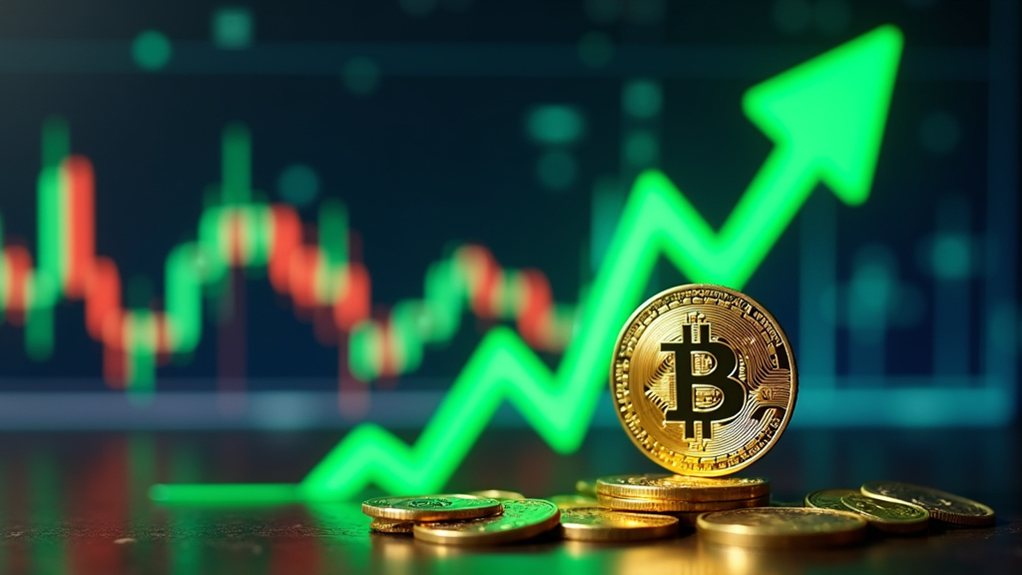In crypto, "bullish" describes a positive market outlook where investors expect prices to rise. It's the opposite of "bearish" sentiment. Bullish markets typically show upward price trends, increased trading volumes, and growing market capitalization. Several factors can trigger bullish sentiment, including favorable regulations, technological improvements, and institutional investment. However, bull markets also carry risks, such as asset overvaluation and increased volatility. The crypto landscape continually evolves with these sentiment shifts.

What exactly does it mean when crypto traders talk about being "bullish"? In the crypto world, being bullish refers to having a positive outlook on the market. When someone is bullish, they expect cryptocurrency prices to rise over time. This sentiment is the opposite of being "bearish," which predicts falling prices. Bullish investors feel confident about future growth and wider adoption of digital currencies.
A bullish crypto market has several key characteristics. Prices show sustained upward trends, trading volumes increase, and market capitalization grows. The overall environment features positive news about cryptocurrencies, with more investors joining the market. These factors create a cycle that can further strengthen bullish sentiment. Bull markets are often driven by institutional adoption and technological advancements in the cryptocurrency space.
Traders and analysts use specific indicators to identify bullish trends. Rising moving averages, such as the 50-day or 200-day, suggest positive momentum. When the Relative Strength Index (RSI) climbs above 70, it often signals strong bullish conditions. Certain candlestick patterns like hammers or bullish engulfing patterns also indicate potential price increases. Position traders often benefit from analyzing longer timeframes when identifying major bullish trends in cryptocurrency markets. Growing institutional investment and healthy on-chain metrics add to these positive signals. Bullish sentiment often reflects overall optimism in the broader cryptocurrency ecosystem.
Technical indicators like RSI readings above 70 and rising moving averages confirm bullish trends, providing traders with actionable market insights.
Many factors can contribute to bullish sentiment in crypto markets. Favorable regulations that provide clarity without stifling innovation tend to boost confidence. Technological improvements to blockchain networks often drive positive price action. When major companies announce they're accepting or investing in crypto, prices typically rise. Broader economic conditions like inflation can also push investors toward cryptocurrencies as alternative investments.
During bullish markets, traders employ various strategies. Some simply buy and hold, expecting long-term appreciation. Others use dollar-cost averaging, regularly purchasing small amounts regardless of price. More active traders might try to capture short-term gains through swing trading. Some use leverage to amplify potential profits, while others spread investments across multiple cryptocurrencies.
Bull markets come with risks. Assets can become overvalued, creating unsustainable bubbles that eventually burst. Price volatility often increases, with sudden corrections possible even during overall uptrends. Fear of missing out (FOMO) can lead to poor investment decisions. Regulatory changes or security issues can quickly reverse positive sentiment.
Crypto history shows several notable bull runs. Bitcoin surged from $1,000 to $20,000 in 2017, while Ethereum rocketed from $10 to $1,400 around the same time. The summer of 2020 saw decentralized finance (DeFi) tokens gain over 1000%. In 2021, the NFT boom drove related cryptocurrencies higher, and Bitcoin reached its all-time high near $69,000.
These examples demonstrate the powerful price movements possible during bullish crypto cycles.
Frequently Asked Questions
How Do You Spot a Bullish Pattern in Crypto Charts?
Traders identify bullish patterns in crypto charts by watching for specific signals.
Key indicators include candlestick formations like hammers and bullish engulfing patterns.
Chart structures such as ascending triangles and cup-and-handle formations suggest upward movement.
Increasing trading volume often confirms bullish trends.
Technical indicators like RSI above 50 or MACD crossing above its signal line also point to potential upward momentum.
Price breaking above resistance levels is another strong signal.
Can News Events Trigger Bullish Trends in Cryptocurrency Markets?
News events frequently trigger bullish trends in cryptocurrency markets.
When Tesla bought $1.5 billion in Bitcoin in 2021, prices jumped 20%. Regulatory approvals, like the SEC's Bitcoin ETF authorization, often spark rallies.
Company announcements from PayPal, Amazon, and MicroStrategy have historically boosted crypto values.
Additionally, technological breakthroughs and macroeconomic factors like inflation can fuel positive market momentum.
These catalysts often create significant price movements across the crypto sector.
What Indicators Suggest a Bullish Reversal Is Coming?
Several indicators can signal a bullish reversal in crypto markets. These include price patterns like double bottoms and hammer candlesticks, technical indicators showing RSI moving from oversold conditions, and MACD crosses.
On-chain data revealing declining exchange balances and increasing active addresses also suggest positive momentum.
Meanwhile, growing positive sentiment in social media, rising long/short ratios, and increasing trading volume during price increases further support bullish outlooks.
How Long Do Typical Crypto Bull Markets Last?
Crypto bull markets typically last between 1-2 years.
Historical data shows the 2013 bull run lasted about 12 months, the 2017 rally extended for 18 months, and the 2020-2021 cycle spanned roughly 15 months.
Bitcoin halving events often trigger these bullish periods.
These cycles are particularly shorter than traditional market bull runs, which can last nearly 4 years for stocks and longer for real estate.
Is DCA a Good Strategy During Bullish Crypto Markets?
Dollar-cost averaging (DCA) remains popular during crypto bull markets. It helps investors reduce risk from price swings by buying fixed amounts regularly.
Studies show this approach minimizes the impact of market timing errors. However, lump-sum investing has historically outperformed DCA in extended uptrends.
Investors typically choose DCA for its simplicity and emotional discipline, even though it may leave some potential profits on the table during strong bull runs.










